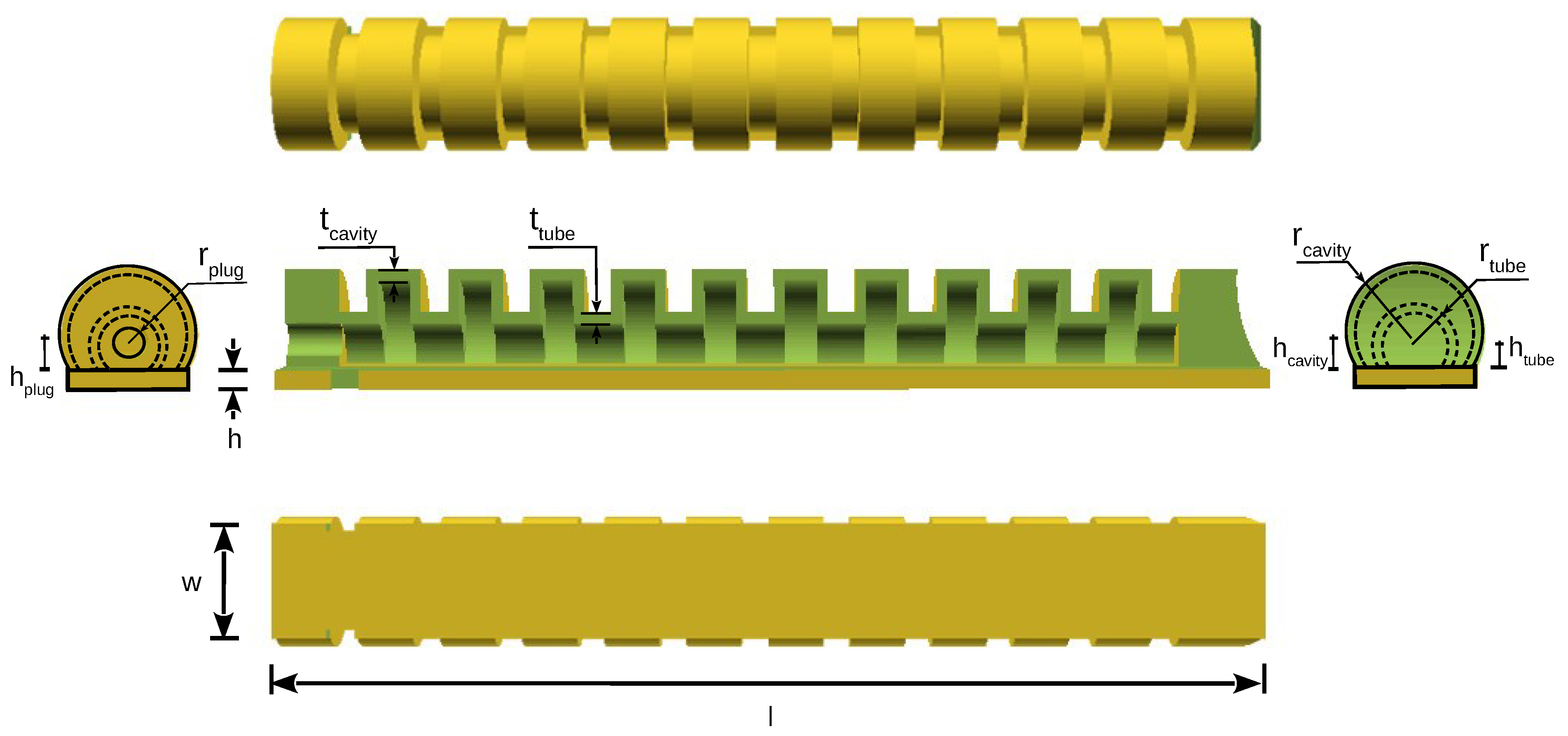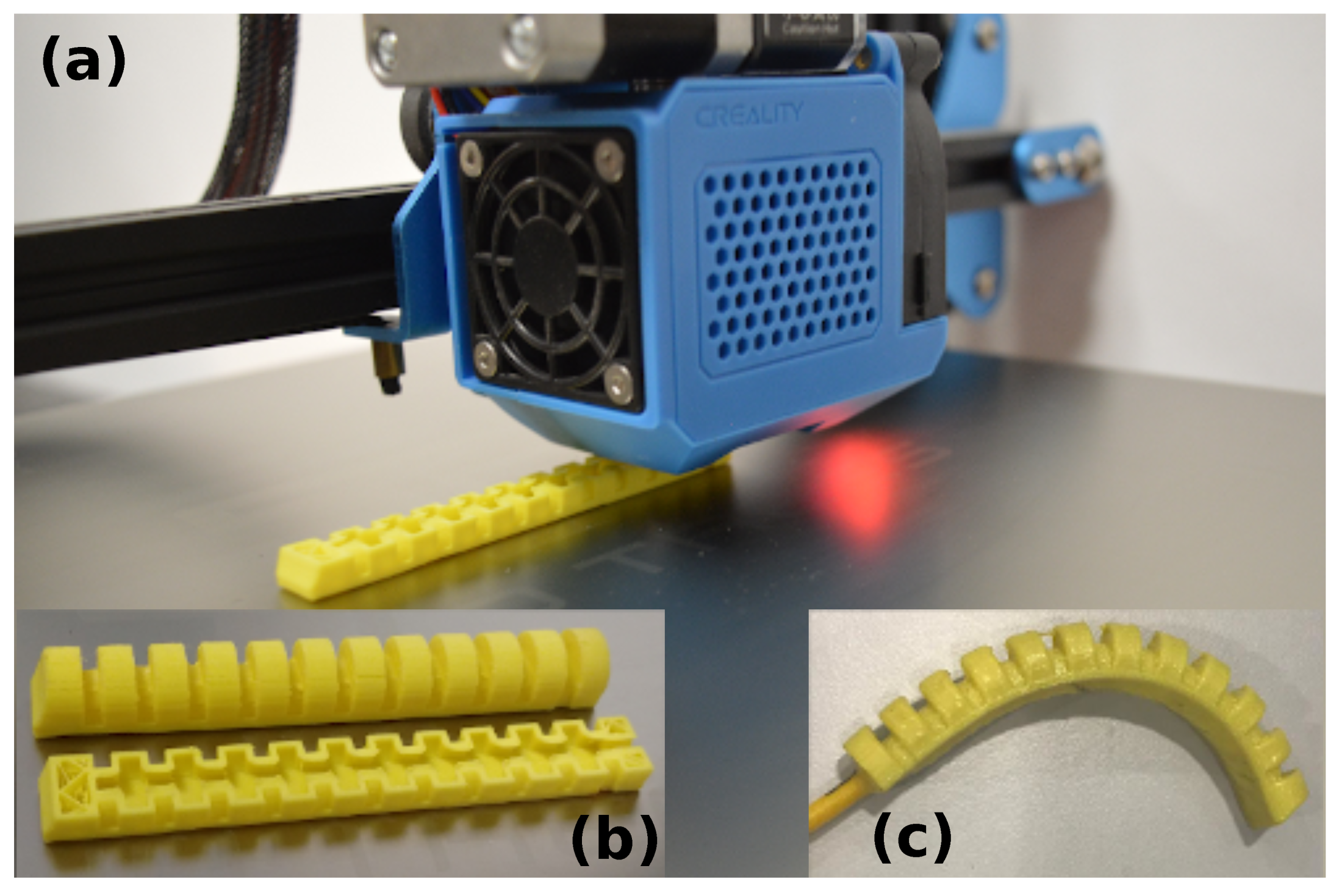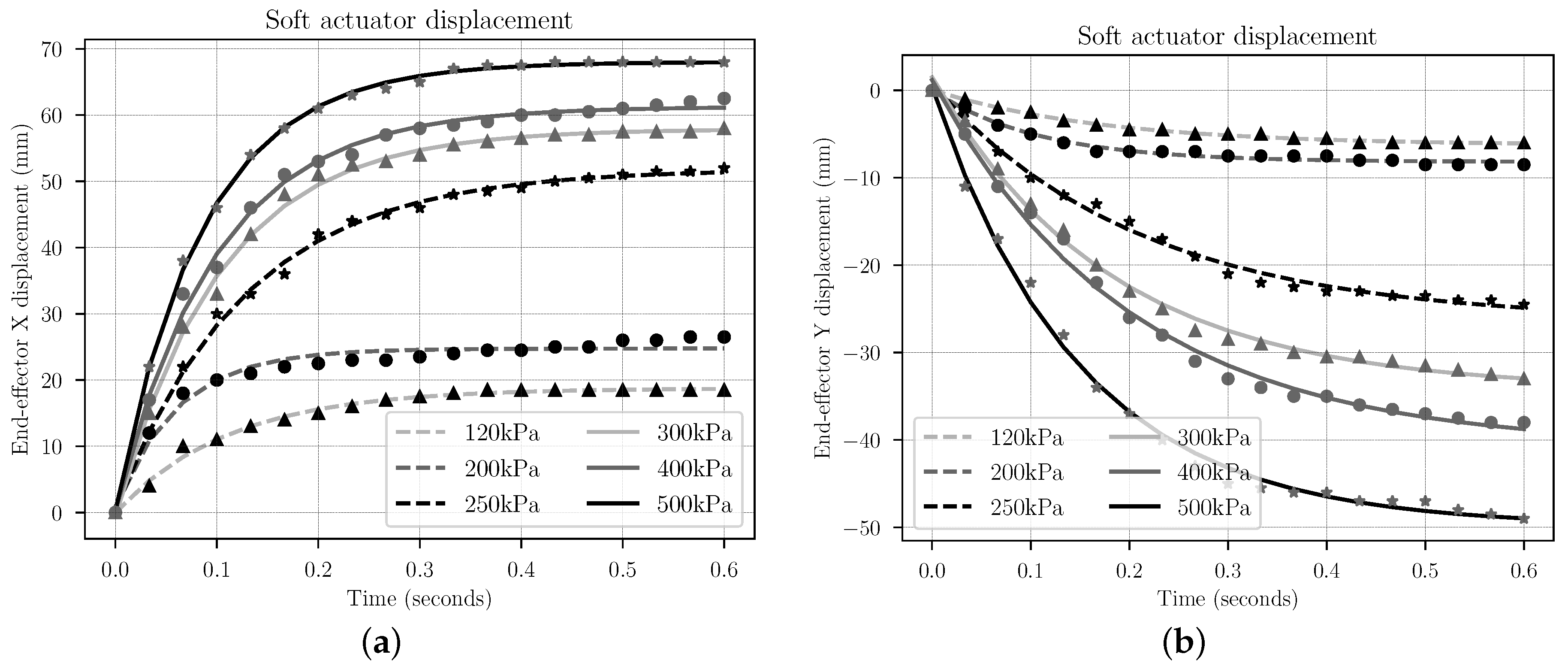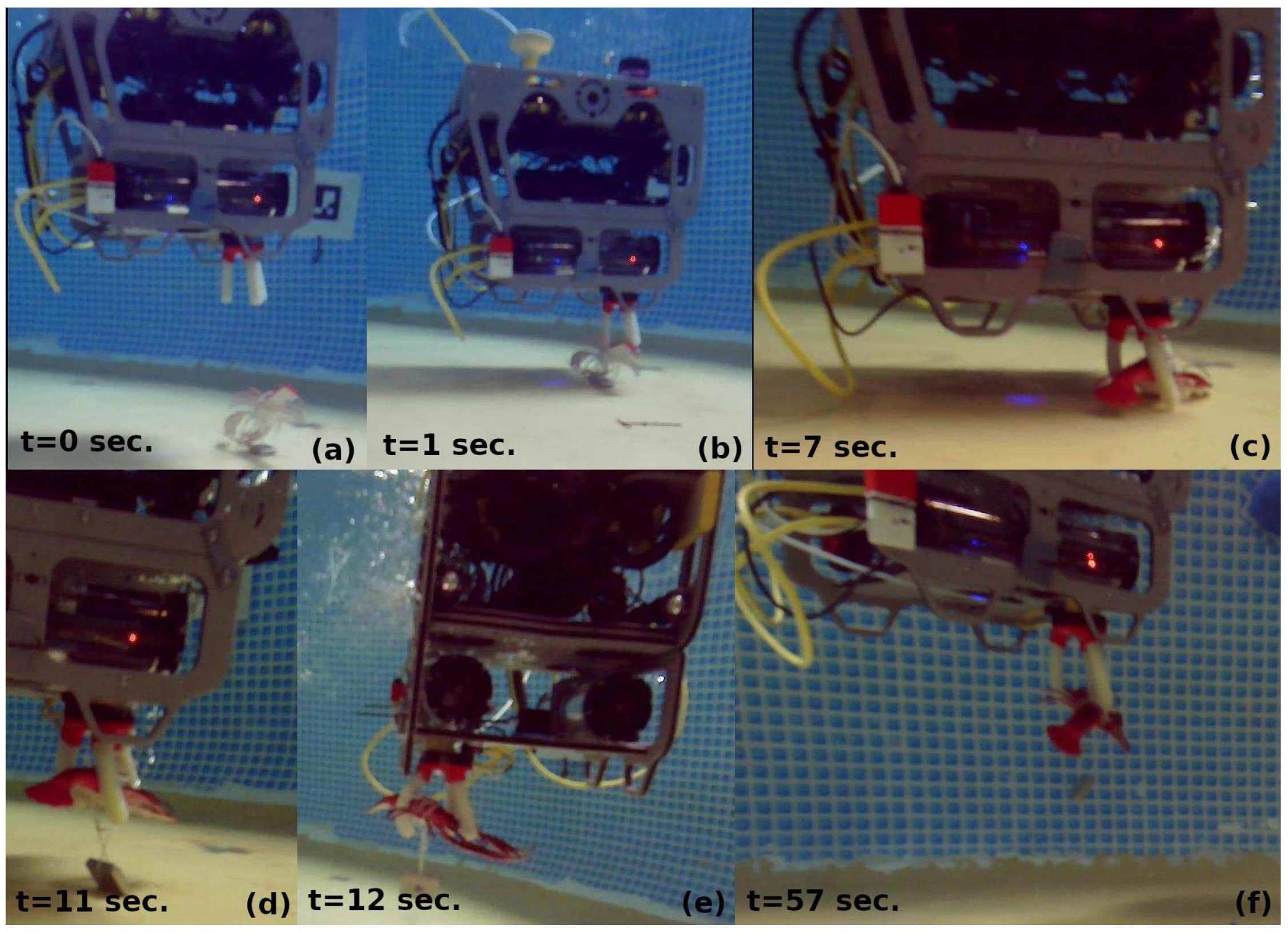Soft Gripper Design and Fabrication for Underwater Grasping
Abstract
1. Introduction
2. Materials and Fabrication Process
3. Soft Fluidic Actuator
3.1. Actuator Design
3.2. Modeling and Simulation
3.3. Fabrication
3.4. Characterization
4. Soft Gripper Design
4.1. Mechanical Design
4.2. Electronics Design
5. Experimental Results
6. Conclusions
Author Contributions
Funding
Institutional Review Board Statement
Informed Consent Statement
Data Availability Statement
Acknowledgments
Conflicts of Interest
References
- Mura, D.; Barbarossa, M.; Dinuzzi, G.; Grioli, G.; Caiti, A.; Catalano, M.G. A Soft Modular End Effector for Underwater Manipulation: A Gentle, Adaptable Grasp for the Ocean Depths. IEEE Robot. Autom. Mag. 2018, 25, 45–56. [Google Scholar] [CrossRef]
- Petillot, Y.R.; Antonelli, G.; Casalino, G.; Ferreira, F. Underwater Robots: From Remotely Operated Vehicles to Intervention-Autonomous Underwater Vehicles. IEEE Robot. Autom. Mag. 2019, 26, 94–101. [Google Scholar] [CrossRef]
- Fernández, J.J.; Prats, M.; Sanz, P.J.; García, J.C.; Marín, R.; Robinson, M.; Ribas, D.; Ridao, P. Grasping for the Seabed: Developing a New Underwater Robot Arm for Shallow-Water Intervention. IEEE Robot. Autom. Mag. 2013, 20, 121–130. [Google Scholar] [CrossRef]
- Peñalver, A.; Fernández, J.J.; Sanz, P.J. Autonomous underwater grasping using multi-view laser reconstruction. In Proceedings of the OCEANS 2017, Aberdeen, UK, 19–22 June 2017; pp. 1–5. [Google Scholar]
- Bemfica, J.R.; Melchiorri, C.; Moriello, L.; Palli, G.; Scarcia, U. A three-fingered cable-driven gripper for underwater applications. In Proceedings of the 2014 IEEE International Conference on Robotics and Automation (ICRA), Hong Kong, China, 31 May–7 June 2014; pp. 2469–2474. [Google Scholar]
- Ribas, D.; Ridao, P.; Turetta, A.; Melchiorri, C.; Palli, G.; Fernandez, J.J.; Sanz, P.J. I-AUV Mechatronics Integration for the TRIDENT FP7 Project. IEEE/ASME Trans. Mechatronics 2015, 20, 2583–2592. [Google Scholar] [CrossRef]
- Simetti, E.; Wanderlingh, F.; Torelli, S.; Bibuli, M.; Odetti, A.; Bruzzone, G.; Rizzini, D.L.; Aleotti, J.; Palli, G.; Moriello, L.; et al. Autonomous Underwater Intervention: Experimental Results of the MARIS Project. IEEE J. Ocean. Eng. 2018, 43, 620–639. [Google Scholar] [CrossRef]
- Koganezawa, K.; Takeuchi, K.; Sakagami, N. Multi Joint Gripper for Underwater ROV-Experimental Verification. In Proceedings of the OCEANS 2019, Marseille, France, 17–20 June 2019; pp. 1–6. [Google Scholar]
- Suzumori, K.; Iikura, S.; Tanaka, H. Development of flexible microactuator and its applications to robotic mechanisms. In Proceedings of the 1991 IEEE International Conference on Robotics and Automation (ICRA), Sacramento, CA, USA, 9–11 April 1991; pp. 1622–1627. [Google Scholar]
- Suzumori, K.; Iikura, S.; Tanaka, H. Applying a flexible microactuator to robotic mechanisms. IEEE Control Syst. Mag. 1992, 12, 21–27. [Google Scholar]
- Caldwell, D.G.; Tsagarakis, N. Soft grasping using a dextrous hand. Ind. Robot 2000, 27, 194–199. [Google Scholar] [CrossRef]
- Catalano, M.G.; Grioli, G.; Farnioli, E.; Serio, A.; Piazza, C.; Bicchi, A. Adaptive synergies for the design and control of the Pisa/IIT SoftHand. Int. J. Robot. Res. 2014, 33, 768–782. [Google Scholar] [CrossRef]
- Lane, D.M.; Davies, J.B.C.; Casalino, G.; Bartolini, G.; Cannata, G.; Veruggio, G.; Canals, M.; Smith, C.; O’Brien, D.J.; Pickett, M.; et al. AMADEUS: Advanced manipulation for deep underwater sampling. IEEE Robot. Autom. Mag. 1997, 4, 34–45. [Google Scholar] [CrossRef]
- Lane, D.M.; Bartolini, G.; Cannata, G.; Casalino, G.; Davies, J.B.C.; Veruggio, G.; Canals, M.; Smith, C. Advanced manipulation for deep underwater sampling: The AMADEUS research project. In Proceedings of the 1998 IEEE International Conference on Control Applications (Cat. No.98CH36104), Trieste, Italy, 4 September 1998; pp. 1068–1073. [Google Scholar]
- Galloway, K.C.; Becker, K.P.; Phillips, B.; Kirby, J.; Licht, S.; Tchernov, D.; Wood, R.J.; Gruber, D.F. Soft Robotic Grippers for Biological Sampling on Deep Reefs. Soft Robot. 2016, 3, 23–33. [Google Scholar] [CrossRef]
- Rus, D.; Tolley, M.T. Design, fabrication and control of soft robots. Nature 2015, 521, 467–475. [Google Scholar] [CrossRef] [PubMed]
- Navas, E.; Fernández, R.; Sepúlveda, D.; Armada, M.; Gonzalez-de Santos, P. Soft Grippers for Automatic Crop Harvesting: A Review. Sensors 2021, 21, 2689. [Google Scholar] [CrossRef] [PubMed]
- Stuart, H.; Wang, S.; Khatib, O.; Cutkosky, M.R. The Ocean One hands: An adaptive design for robust marine manipulation. Int. J. Robot. Res. 2017, 36, 150–166. [Google Scholar] [CrossRef]
- Vogt, D.M.; Becker, K.P.; Phillips, B.T.; Graule, M.A.; Rotjan, R.D.; Shank, T.M.; Cordes, E.E.; Wood, R.J.; Gruber, D.F. Shipboard design and fabrication of custom 3D-printed soft robotic manipulators for the investigation of delicate deep-sea organisms. PLoS ONE 2018, 13, e0200386. [Google Scholar] [CrossRef] [PubMed]
- Feng, H.; Sun, Y.; Todd, P.A.; Lee, H.P. Body Wave Generation for Anguilliform Locomotion Using a Fiber-Reinforced Soft Fluidic Elastomer Actuator Array Toward the Development of the Eel-Inspired Underwater Soft Robot. Soft Robot. 2020, 7, 233–250. [Google Scholar] [CrossRef]
- Kurumaya, S.; Phillips, B.T.; Becker, K.P.; Rosen, M.H.; Gruber, D.F.; Galloway, K.C.; Suzumori, K.; Wood, R.J. A Modular Soft Robotic Wrist for Underwater Manipulation. Soft Robot. 2018, 5, 339–409. [Google Scholar] [CrossRef]
- Shen, Z.; Zhong, H.; Xu, E.; Zhang, R.; Yip, K.C.; Chan, L.L.; Chan, L.L.; Pan, J.; Wang, W.; Wang, Z. An Underwater Robotic Manipulator with Soft Bladders and Compact Depth-Independent Actuation. Soft Robot. 2020, 7, 535–549. [Google Scholar] [CrossRef]
- Hughes, J.; Culha, U.; Giardina, F.; Guenther, F.; Rosendo, A.; Iida, F. Soft manipulators and grippers: A review. Front. Robot. AI 2016, 3, 69. [Google Scholar] [CrossRef]
- Stokes, A.A.; Shepherd, R.F.; Morin, S.A.; Ilievski, F.; Whitesides, G.M. A Hybrid Combining Hard and Soft Robots. Soft Robot. 2013, 1, 70–74. [Google Scholar] [CrossRef]
- Ogura, K.; Wakimoto, S.; Suzumori, K.; Nishioka, Y. Micro pneumatic curling actuator-Nematode actuator. In Proceedings of the 2008 IEEE International Conference on Robotics and Biomimetics, Bangkok, Thailand, 22–25 February 2008; pp. 462–467. [Google Scholar]
- Johnston, I.D.; McCluskey, D.K.; Tan, C.K.L.; Tracey, M.C. Mechanical characterization of bulk Sylgard 184 for microfluidics and microengineering. J. Micromech. Microeng. 2014, 24, 035017. [Google Scholar] [CrossRef]
- Park, Y.L.; Majidi, C.; Kramer, R.; Bérard, P.; Wood, R.J. Hyperelastic pressure sensing with a liquid-embedded elastomer. J. Micromech. Microeng. 2010, 20, 125029. [Google Scholar] [CrossRef]
- Suzumori, K.; Koga, A.; Riyoko, H. Microfabrication of integrated FMAS using stereo lithography. In Proceedings of the IEEE Micro Electro Mechanical Systems An Investigation of Micro Structures, Sensors, Actuators, Machines and Robotic Systems, Oiso, Japan, 25–28 January 1994; pp. 136–141. [Google Scholar]
- Qi, H.J.; Boyce, M.C. Stress–strain Behavior of Thermoplastic Polyurethanes. Mech. Mater. 2005, 37, 817–839. [Google Scholar] [CrossRef]
- Ilievski, F.; Mazzeo, A.D.; Shepherd, R.F.; Chen, X.; Whitesides, G.M. Soft Robotics for Chemists. Angew. Chem. Int. Ed. Engl. 2011, 50, 1890–1895. [Google Scholar] [CrossRef] [PubMed]
- Deimel, R.; Brock, O. A novel type of compliant and underactuated robotic hand for dexterous grasping. Int. J. Robot. Res. 2016, 35, 161–185. [Google Scholar] [CrossRef]
- Georgopoulou, A.; Vanderborght, B.; Clemens, F. Fabrication of a Soft Robotic Gripper With Integrated Strain Sensing Elements Using Multi-Material Additive Manufacturing. Front. Robot. AI 2021, 8, 615991. [Google Scholar] [CrossRef] [PubMed]
- Herrero-Pérez, D.; Martínez-Castejón, P. Multi-GPU acceleration of large-scale density-based topology optimization. Adv. Eng. Softw. 2021, 157–158, 103006. [Google Scholar] [CrossRef]
- Karypis, G.; Kumar, V. Multilevel k-way partitioning scheme for irregular graphs. J. Parallel Dist. Com. 1998, 48, 96–129. [Google Scholar] [CrossRef]
- Karypis, G.; Schloegel, K. ParMeTis: Parallel Graph Partitioning and Sparse Matrix Ordering Library, Version 4.0; Technical Report; University of Minnesota: Minneapolis, MN, USA, 2013. [Google Scholar]
- Scharff, R.B.N.; Wu, J.; Geraedts, J.M.P.; Wang, C.C.L. Reducing Out-of-Plane Deformation of Soft Robotic Actuators for Stable Grasping. In Proceedings of the 2019 2nd IEEE International Conference on Soft Robotics (RoboSoft), Seoul, Korea, 14–18 April 2019; pp. 265–270. [Google Scholar]
- Ward, I.M.; Sweeney, J. Mechanical Properties of Solid Polymers: Third Edition; John Wiley & Sons, Ltd.: Chichester, UK, 2012. [Google Scholar]
- Laranjeira, M.; Dune, C.; Hugel, V. Catenary-based visual servoing for tether shape control between underwater vehicles. Ocean Eng. 2020, 200, 107018. [Google Scholar] [CrossRef]
- Martínez-Barberá, H.; Bernal-Polo, P.; Herrero-Pérez, D. Sensor Modeling for Underwater Localization Using a Particle Filter. Sensors 2021, 21, 1549. [Google Scholar] [CrossRef] [PubMed]










| Parameter | Description | Value |
|---|---|---|
| l | Length of the actuator | 90 mm |
| w | Width of the actuator | 10 mm |
| h | Height of the actuator | 1.75 mm |
| Height of the center of cavity | 5 mm | |
| Height of the center of internal cavity | 2.5 mm | |
| Height of the hole’s center to pressurize the actuator | 2.5 mm | |
| Thickness of the cavity | 1 mm | |
| Thickness of the internal cavity | 1 mm | |
| External radious of the cavity | 6 mm | |
| External radious of the internal cavity | 4.5 mm | |
| External radious of the hole to pressurize the actuator | 1.75 mm |
Publisher’s Note: MDPI stays neutral with regard to jurisdictional claims in published maps and institutional affiliations. |
© 2022 by the authors. Licensee MDPI, Basel, Switzerland. This article is an open access article distributed under the terms and conditions of the Creative Commons Attribution (CC BY) license (https://creativecommons.org/licenses/by/4.0/).
Share and Cite
Herrero-Pérez, D.; Martínez-Barberá, H. Soft Gripper Design and Fabrication for Underwater Grasping. Appl. Sci. 2022, 12, 10694. https://doi.org/10.3390/app122110694
Herrero-Pérez D, Martínez-Barberá H. Soft Gripper Design and Fabrication for Underwater Grasping. Applied Sciences. 2022; 12(21):10694. https://doi.org/10.3390/app122110694
Chicago/Turabian StyleHerrero-Pérez, David, and Humberto Martínez-Barberá. 2022. "Soft Gripper Design and Fabrication for Underwater Grasping" Applied Sciences 12, no. 21: 10694. https://doi.org/10.3390/app122110694
APA StyleHerrero-Pérez, D., & Martínez-Barberá, H. (2022). Soft Gripper Design and Fabrication for Underwater Grasping. Applied Sciences, 12(21), 10694. https://doi.org/10.3390/app122110694








